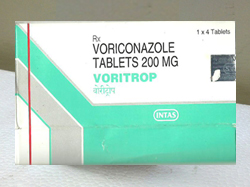Voriconazole is a triazole medicine used to treat fungal infections. It is effective against a broad spectrum of fungi and is usually reserved for the treatment of serious Candida and mould infections. It is indicated for the treatment of the following infections:
- Fluconazole - resistant serious invasive Candida infections (including C. krusei)
- Oesophageal candidiasis
- Invasive aspergillosis
- Serious fungal infections caused by Scedosporium spp and Fusarium spp
- Other serious fungal infections, in patients intolerant of, or unresponsive to, other therapy
In New Zealand, voriconazole is available as 50 mg and 200 mg tablets, 45 g bottle of powder to make a 40mg/ml oral suspension, and as 200mg lyophilised powder for intravenous injection. The trade name for voriconazole is VFEND® and is only available with a doctor’s prescription.
Voriconazole binds to the fungal p450 enzymes and stops the cells making ergosterol, the main component of the cell wall.
Pharmacokinetics
Voriconazole is rapidly and almost completely absorbed following oral administration. It is widely distributed in body tissues. The terminal half-life (for half of the medication to be cleared from the blood stream) of voriconazole is dose-dependent and is approximately 6 hours for a 200mg oral dose. Because of non-linear pharmacokinetics, the terminal half-life is not useful in the prediction of accumulation or elimination of voriconazole. Voriconazole is eliminated via hepatic metabolism with less than 2% of the dose excreted unchanged in the urine.
Dose regime
Intravenous or oral administration can be given to treat fluconazole resistant serious invasive Candida infections, invasive aspergillosis, Scedosporium and Fusarium infections and other serious fungal infections. The recommended adult dose is:
- IV – 6mg/kg every 12 hr (for first 24 hr) followed by 4mg/kg every 12 hr
- Oral
- patients > 40kg - 400mg every 12 hr (for first 24 hr) followed by 200mg twice daily
- patients < 40kg - 200mg every 12 hr (for first 24 hr) followed by 100mg twice daily
Oesophageal candidiasis is normally treated with oral voriconazole using the same oral doses as for other infections above.
If clinical response is inadequate, the oral maintenance dose may be increased to 300mg twice daily in patients >40kg and 150mg twice daily in patients <40kg.
The dosage for children aged 2 to <12 years is 6mg/kg every 12 hr (for first 24 hr) followed by 4mg/kg every 12 hr administered either intravenously or orally.
How to take voriconazole
- Voriconazole should be taken at least one hour before on one hour after a meal.
- Tablets should be swallowed whole with a full glass of water.
- Voriconazole should be taken regularly at about the same time each day.
- Do not stop taking voriconazole until you have finished the full course, even if you are feeling better. Your symptoms may begin to improve before the infection is completely treated.
- Shake suspension well before measuring the dose. Do not refrigerate or freeze suspension and discard any unused suspension after 14 days.
Side effects
The more common side effects of voriconazole are usually mild and short-lived. These include:
- Nausea and vomiting
- Headache
- Stomach pain, indigestion, diarrhoea
- Swelling or water retention of the arms or legs
- Blurred vision, increased eye sensitivity to light
- Soreness at the injection site
- Photosensitivity resulting in unexpected sunburn on exposed skin
If you experience any of the following serious side effects, stop taking voriconazole and seek emergency medical attention or contact your doctor immediately:
- An allergic reaction (swelling of the face, lips or tongue, hives, difficulty breathing)
- Sudden or severe itching, skin rash, hives or blisters, flaking of the skin
- Asthma, wheezing, shortness of breath
- Fainting, seizures or fits
Voriconazole should not be taken in pregnancy except in patients with severe or potentially life-threatening fungal infections and the benefit to the mother clearly outweighs the potential risk to the foetus. Use during breast-feeding is not generally recommended, as it is not known whether voriconazole is excreted in breast milk.




